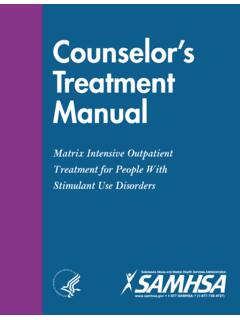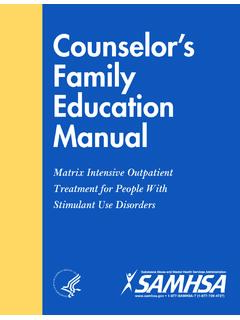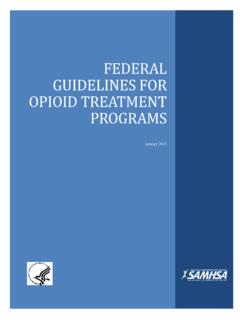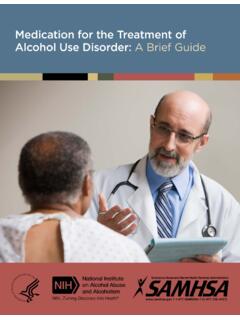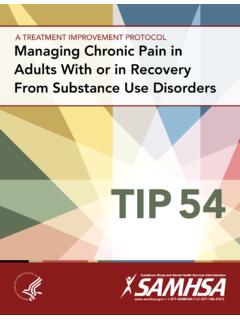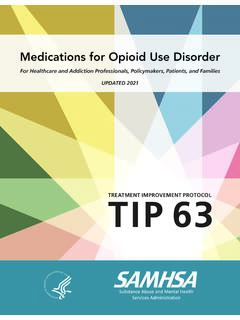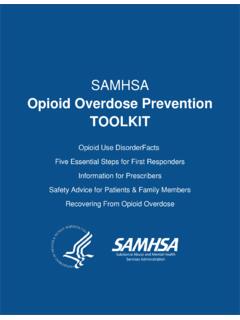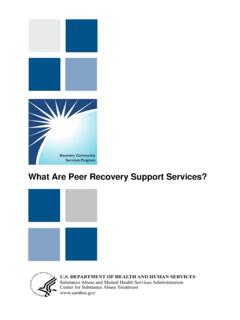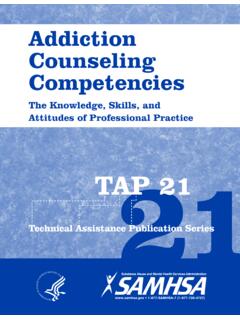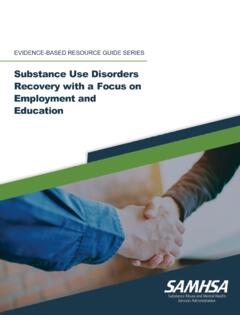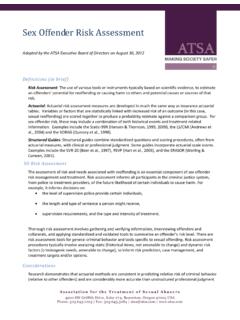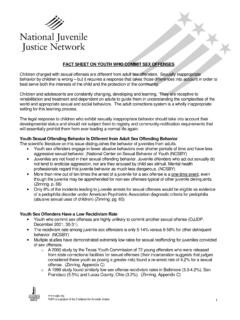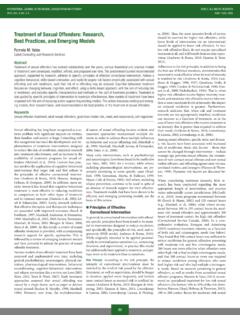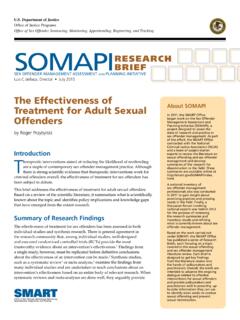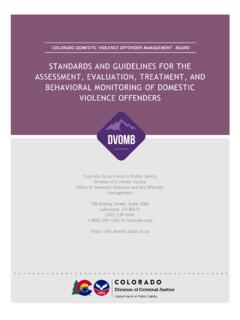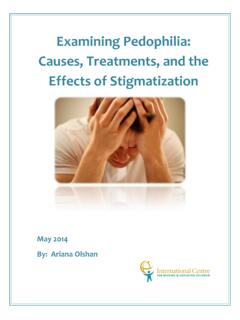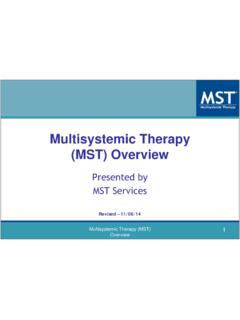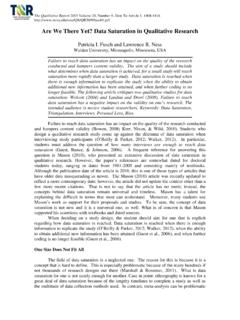Transcription of TIP 44 Substance Abuse Treatment For Adults in the ...
1 Substance Abuse Treatment For Adults in the Criminal Justice System A Treatment Improvement Protocol TIP. 44. Substance Abuse Treatment For Adults in the Criminal Justice System A Treatment Improvement Protocol TIP. 44. DEPARTMENT OF HEALTH AND HUMAN SERVICES. Public Health Service Substance Abuse and Mental Health Services Administration Center for Substance Abuse Treatment 1 Choke Cherry Road Rockville, MD 20857. Acknowledgments Recommended Citation This publication was prepared under contract Center for Substance Abuse Treatment . numbers 270-99-7072 and 270-04-7049 by the Substance Abuse Treatment for Adults in the Knowledge Application Program, a Joint Criminal Justice System. Treatment Venture of The CDM Group, Inc. and JBS Improvement Protocol (TIP) Series 44.
2 HHS. International, Inc., for the Substance Abuse Publication No. (SMA) 13-4056. Rockville, and Mental Health Services Administration MD: Substance Abuse and Mental Health (SAMHSA), Department of Health and Services Administration, 2005. Human Services (HHS). Christina Currier served as the Government Project Officer. Originating Office Disclaimer Quality Improvement and Workforce Development Branch, Division of Services The views, opinions, and content expressed Improvement, Center for Substance Abuse herein are those of the authors and do not Treatment , Substance Abuse and Mental necessarily reflect the views, opinions, or Health Services Administration, 1 Choke policies of SAMHSA or HHS. Cherry Road, Rockville, MD 20857. Public Domain Notice HHS Publication No.
3 (SMA) 13-4056. All materials appearing in this volume except Printed 2005. those taken directly from copyrighted sources Reprinted 2009, 2011, 2013, and 2014. are in the public domain and may be repro- duced or copied without permission from SAMHSA or the authors. Citation of the source is appreciated. However, this publica- tion may not be reproduced or distributed for a fee without the specific, written authoriza- tion of the Office of Communications, SAMHSA, HHS. Electronic Access and Copies of Publication TThis publication may be ordered from or downloaded from SAMHSA's Publications Ordering Web page at Or, please call 1-877-SAMHSA-7. (1-877-726-4727) (English and Espa ol). ii Acknowledgments Contents What Is a TIP? ..ix Consensus Panel ..xi KAP Expert Panel and Federal Government Participants.
4 Xiii Foreword ..xv Executive Summary ..xvii Chapter 1 Introduction ..1. The Purpose of This TIP ..3. Key Definitions ..4. Audience for This Contents of This Chapter 2 Screening and Assessment ..7. Definitions of Screening Guidelines ..9. Assessment Key Issues Related to Screening and Areas To Address in Screening and Assessment ..18. Selection and Implementation of Instruments ..33. Screening and Assessment Considerations for Specific Populations ..36. Integrated Screening and Assessment Sample Approaches ..39. Conclusions and Recommendations ..40. Chapter 3 Triage and Placement in Treatment Services ..43. Overview ..43. Treatment Levels and Potential Barriers to Triage and Creating a Triage and Placement System ..47. Compiling Information To Guide Triage and Placement Conclusions and Recommendations.
5 56. Chapter 4 Substance Abuse Treatment Planning ..59. Overview ..59. Assessing the Severity of Substance Use Disorders ..60. Assessing the Severity of Co-Occurring Disorders ..60. Criminality and Psychopathy ..63. Client Motivation and Readiness for Change ..65. Implementing an Effective Treatment Planning Process ..67. Conclusions and Recommendations ..70. Chapter 5 Major Treatment Issues and Approaches ..71. Overview ..71. Clinical Strategies ..72. iii Program Components and Strategies ..84. Conclusions and Recommendations ..90. Chapter 6 Adapting offender Treatment for Specific Populations ..93. Overview ..93. Treatment Issues Related to Cultural Minorities ..93. Women's Treatment Issues ..95. Men's Treatment Working With Violent Offenders ..102. Treatment Issues Based on Client's sexual Orientation.
6 104. Treatment Issues Based on the Client's Cognitive/Learning, Physical, and Sensory Disabilities ..105. Treatment Issues for Older Adults ..107. Treatment Issues for Clients From Rural Areas ..107. Treatment Issues for People With Co-Occurring Substance Use and Mental Disorders ..108. People With Infectious Diseases ..116. Sex Conclusions and Recommendations ..122. Chapter 7 Treatment Issues in Pretrial and Diversion Introduction ..125. Characteristics of the Population ..126. Treatment Services in the Pretrial Justice System ..127. Trial and Postverdict Diversion to Treatment ..131. What Treatment Services Can Reasonably Be Provided in the Pretrial Setting?..138. Treatment Issues ..143. Developing Pretrial Treatment Services ..146. Conclusions and Recommendations.
7 154. Chapter 8 Treatment Issues Specific to Treatment Services in Jails ..159. Description of the Key Issues Related to Treatment ..163. What Treatment Services Can Reasonably Be Provided in a Jail Setting?..166. Coordination of Jail Treatment Services ..175. Examples of Jail Treatment Programs ..183. Research Related to Jail Treatment ..184. Recommendations for Treatment Providers ..185. Chapter 9 Treatment Issues Specific to Prisons ..187. Description of the Treatment Services in Prisons ..190. iv Contents Key Issues Affecting Treatment in Prison Settings ..190. What Treatment Services Can Reasonably Be Provided in the Prison Setting? ..194. In-Prison Therapeutic Communities ..199. Specific Populations in Systems Issues ..207. Recommendations and Further Research.
8 210. Chapter 10 Treatment for Offenders Under Community Supervision ..213. The Levels of Supervision ..214. Treatment Levels and Treatment Components ..214. What Treatment Services Can Reasonably Be Provided for People Under Community Supervision? ..218. Treatment Issues for People Under Community Supervision ..220. Treatment Issues Specific to People on Parole ..226. Treatment Issues Specific to Probationers ..229. Strategies for Improving System Collaboration ..229. Sample Programs ..231. Conclusions and Recommendations ..233. Chapter 11 Key Issues Related to Program Reconciling Public Safety and Public Health Interests ..235. Interdependence of Criminal Justice and Treatment Systems ..236. Program-Level Research and Evaluation ..247. Cost Key Goals of SAMHSA.
9 252. Conclusions ..252. Appendix A: Bibliography ..255. Appendix B: Glossary ..291. Appendix C: Screening and Assessment Instruments ..303. Appendix D: Resource Appendix E: Cultural Competency and Diversity Network Participants ..313. Appendix F: Special Consultants ..315. Appendix G: Field Appendix H: Index ..321. CSAT TIPs and Figures Figure 2-1. Screening Guidelines by Figure 2-2. Screening Guidelines by Figure 2-3. Recommended Substance Abuse Screening Instruments ..19. Contents v Figure 2-4. Instruments for Evaluating Readiness for Treatment ..23. Figure 2-5. Instruments for Screening and Assessing Mental Disorders ..25. Figure 2-6. Instruments Examining Psychopathy and Risk for Violence and Figure 3-1. Placement and Triage Strategies ..50. Figure 4-1. Client's Recovery Plan (CRP).
10 68. Figure 5-1. Common Thinking Errors ..75. Figure 5-2. Strategies for Working With Offenders Based on Their Stage in Recovery ..84. Figure 6-1. Traits of ASPD (DSM-IV)..113. Figure 6-2. Borderline Personality Disorder ..114. Figure 7-1. Substance Abuse Treatment Planning Chart for Treatment -Based Drug Courts ..134. Figure 8-1. Treatment Figure 8-2. Goals of the Treatment and Corrections System in the Jail Figure 8-3. Targeted Treatment for Special Populations Versus Mainstream Treatment for Larger Populations ..178. Figure 8-4. Varied Opinions Regarding Medication Use for Inmates in Jail Treatment Programs 180. Figure 9-1. Reasons for Limitations to Providing Treatment to Prison Figure 9-2. Guidelines for Substance Abuse Treatment in Correctional Facilities.
